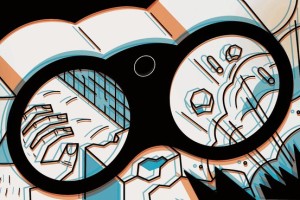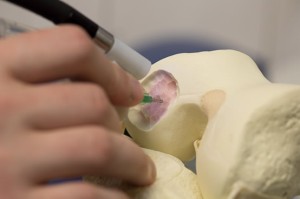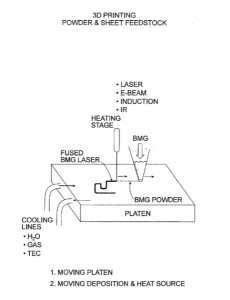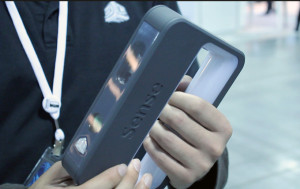First Trifocal 3D film on show at NAB
Walt Disney Studios’ experimental live action 3D film “Make/Believe” will be shown at NAB in Las Vegas next month. Currently in the final stages of post production, the 10-minute 3D short was shot with a new trifocal camera system. ”Make/Believe” was produced by German research institute Fraunhofer HHI with Disney and Berlin firm Real Life Films using Fraunhofer’s hybrid camera system and software. The film will be shown in the Fraunhofer booth at NAB.
 “The system, which comprises a rig mounted with two satellite mini-cams either side of the main ARRI Alexa camera, is used to record 2D pictures and to generate depth maps for creating stereoscopic 3D in post,” reports Adrian Pennington for TVBEurope.
“The system, which comprises a rig mounted with two satellite mini-cams either side of the main ARRI Alexa camera, is used to record 2D pictures and to generate depth maps for creating stereoscopic 3D in post,” reports Adrian Pennington for TVBEurope.
Benefits of the system include the ability to shoot 3D on the same schedule as 2D. “The second benefit is that compared to native stereo 3D you do not first burn in your target screen size. You can do that in post,” said Tanger. “Also, you can create all 3D creative decisions and adjustments for disparity in post so that you do not need a stereographer on set.”
See the full story here: http://www.tvbeurope.com/main-content/full/first-trifocal-3d-film-on-show-at-nab/#.Uyu88txiBrg
3-D Is in Focus at Videogame Conference
 Virtual reality is closely linked to 3-D technology, which has long been used in movie theaters and is spreading rapidly to other applications. Companies such as Valve Corp., famous for its "Half-Life" and "Portal" videogame franchises, developed products for using this technology in videogames. Virtual-reality goggles instead have built-in displays to help convey the effect of entering a simulated world, instead of relying on transparent 3-D glasses for viewing a movie or TV screen.
Virtual reality is closely linked to 3-D technology, which has long been used in movie theaters and is spreading rapidly to other applications. Companies such as Valve Corp., famous for its "Half-Life" and "Portal" videogame franchises, developed products for using this technology in videogames. Virtual-reality goggles instead have built-in displays to help convey the effect of entering a simulated world, instead of relying on transparent 3-D glasses for viewing a movie or TV screen.
It's unclear how the market might react to more combinations of goggles and videogames. Consumers have shown little excitement so far about 3-D television, in part because of the need to wear glasses that augment images on the display.
See the full story here: http://online.wsj.com/news/articles/SB10001424052702303546204579439864044706836?mg=reno64-wsj&url=http%3A%2F%2Fonline.wsj.com%2Farticle%2FSB10001424052702303546204579439864044706836.html&fpid=2,7,121,122,201,401,641,1009
2013: The Best Computing Stories of the Year
Although the groundwork was laid in previous years, in 2013 it became apparent that computers mounted on your wrist and face will preoccupy the computing industry for years to come.
...
We also saw researchers and startups create novel technologies that could make future smart watches easier to use. Many mobile developers adapted their apps for wrist-mounted screens or created new ones for such devices; a company called Chirp developed a compact ultrasonic sensor that allows a small device to recognize gestures; and researchers at Carnegie Mellon invented a simple touch keyboard app for accurate typing on tiny screens.
Despite the activity, it’s not yet clear quite how smart watches will fit into our lives. Intel’s lead gadget anthropologist, Genevieve Bell, told us that the computing industry has yet to figure out what problem smart watches solve for people. However, as we noted in a lengthy review of the smart watches available so far, few live up to what seems to be the promise of the form factor—helping people manage their digital life with fewer interruptions to their offline life.
Au Revoir, ESPN 3D
 ESPN will discontinue its 3D channel at the end of the year, the sports franchise confirmed today. The stereoscopic channel, launched in 2010, is being pulled “due to limited viewer adoption,” a spokeswoman said.
ESPN will discontinue its 3D channel at the end of the year, the sports franchise confirmed today. The stereoscopic channel, launched in 2010, is being pulled “due to limited viewer adoption,” a spokeswoman said.
- See more at: http://www.tvtechnology.com/article/au-revoir-espn-d-/219857#sthash.hEyqfOtu.dpuf
See the full story here: http://www.tvtechnology.com/article/au-revoir-espn-d-/219857
Surgical 3D printing BioPen writes in bone, nerve and muscle
[Phil Lelyveld comment: can you say bio-digital glue gun!]
 The BioPen uses a stem cell ink which can be coaxed into differentiating into muscle, bone, or nerve cells. A seaweed-based growth culture encourages the cells to thrive in their new environment while a second polymer, cured by the use of a UV light, provides a protective shell during the healing process. The complex and adaptive bio-ink can even be further augmented to include growth hormone and other substances that would encourage rapid recovery.
The BioPen uses a stem cell ink which can be coaxed into differentiating into muscle, bone, or nerve cells. A seaweed-based growth culture encourages the cells to thrive in their new environment while a second polymer, cured by the use of a UV light, provides a protective shell during the healing process. The complex and adaptive bio-ink can even be further augmented to include growth hormone and other substances that would encourage rapid recovery.
See the full story here: http://www.dvice.com/2013-12-11/surgical-3d-printing-biopen-writes-bone-nerve-and-muscle
Structure Sensor: iPad 3D Scanner that can capture a whole room!
The Structure Sensor can be used on anything and you don’t have to stand still or place an object into a 3D scanner machine. This device is added on to your iPad, and you can literally walk around and scan entire objects or environments down to the smallest detail. Not only does it scan, meaning creating a wireframe mesh out of the things it sees, but it textures it naturally so it looks like a photorealistic copy of the real thing at the same time. It is a mind-boggling thing to see and to think that it is all possible with a little device added onto your iPad is just an unearthly feeling.
The Structure Sensor is currently being refined and perfected for the consumer market but you can pre-order it over at Occipital, the developer of the device, for the price of $349.00.
See the full story here: http://www.bitrebels.com/technology/structure-sensor-ipad-3d-scanner/
Apple filed five Liquidmetal patents, two are 3D printing related #3DThursday #3DPrinting
[Philip Lelyveld comment: I'm pretty sure that there is prior art for both of these filings. Maybe they're just trying to see what they can get past the reviewers.]  The US Patent & Trademark Office published today a new series of five Liquidmetal patent applications from Apple which were originally filed in Q2 2012. Two of Apple’s inventions are related to 3D printing. They are methods of construction a part with build metallic glasses (BMG – Liquidmetal) layer by layer.
The US Patent & Trademark Office published today a new series of five Liquidmetal patent applications from Apple which were originally filed in Q2 2012. Two of Apple’s inventions are related to 3D printing. They are methods of construction a part with build metallic glasses (BMG – Liquidmetal) layer by layer.
In one embodiment, a layer of BMG powder is deposited to selected positions and then fused to a layer below by suitable methods such as laser heating or electron beam heating. The deposition and fusing are then repeated as need to construct the part layer by layer. One or more layers of non-BMG can be used as needed. In one embodiment, layers of BMG can be cut from one or more sheets of BMG to desired shapes, stacked and fused to form the part.
Another method is to selectively deposite molten bulk metallic glass (BMG). In one embodiment, a continuous stream or discrete droplets of molten BMG is deposited to selected positions. The deposition can be repeated as needed layer by layer. One or more layers of non-BMG can be used as needed.
See the full story here: http://www.adafruit.com/blog/2013/11/21/apple-filed-five-liquidmetal-patents-two-are-3d-printing-related-3dthursday-3dprinting/
Newly launched Smithsonian X 3D Collection offers historical models you can print at home
"The Smithsonian has launched an online collection called the Smithsonian X 3D. The site includes a browser-based 3D viewer that allows users to experience objects that have been scanned, such as artifacts and fossils, up close. In addition, users can download related files in order to print models using their own 3D printer. The project supports 19 museums, 9 research centers and the National Zoo in its goal to expand Smithsonian digital assets." (from ETCentric)
See the full story here: http://www.engadget.com/2013/11/13/smithsonian-x-3d-collection/
See the Smithsonian site here: http://www.3d.si.edu
MIT Invents A Shapeshifting Display You Can Reach Through And Touch
Created by Daniel Leithinger and Sean Follmer and overseen by Professor Hiroshi Ishii, the technology behind the inFORM isn't that hard to understand. It's basically a fancy Pinscreen, one of those executive desk toys that allows you to create a rough 3-D model of an object by pressing it into a bed of flattened pins. With inFORM, each of those "pins" is connected to a motor controlled by a nearby laptop, which can not only move the pins to render digital content physically, but can also register real-life objects interacting with its surface thanks to the sensors of a hacked Microsoft Kinect.
To put it in the simplest terms, the inFORM is a self-aware computer monitor that doesn't just display light, but shape as well. Remotely, two people Skyping could physically interact by playing catch, for example, or manipulating an object together, or even slapping high five from across the planet. Another use is to physically manipulate purely digital objects. A 3-D model, for example, can be brought to life with the inFORM, and then manipulated with your hands to adjust, tweak, or even radically transform the digital blueprint.
Meet Sense, 3D Systems’ Cheap, Dead-Simple 3D Scanner For The Masses
 But here’s the most curious thing about the Sense: everything from the price point to its no-nonsense design to CEO Avi Reichental’s address laden with social media friendly instances of “Sense speak” make it clear that 3D Systems is still intent on trying to crack the consumer market. That’s not exactly unfamiliar territory for the company — it started rolling out a line of consumer-centric 3D printers two years ago, but the cheapest of them still costs a whopping $1,299.
But here’s the most curious thing about the Sense: everything from the price point to its no-nonsense design to CEO Avi Reichental’s address laden with social media friendly instances of “Sense speak” make it clear that 3D Systems is still intent on trying to crack the consumer market. That’s not exactly unfamiliar territory for the company — it started rolling out a line of consumer-centric 3D printers two years ago, but the cheapest of them still costs a whopping $1,299.
That stands in stark contrast to the hefty price tag of Makerbot’s flagship Replicator 2, but even that lowered price barrier is enough to ensure that mass-market adoption of 3D printers (and the devices that support them) is still a ways off.
See the full story here: http://techcrunch.com/2013/11/10/meet-sense-3d-systems-cheap-dead-simple-3d-scanner-for-the-masses/?ncid=tcdaily